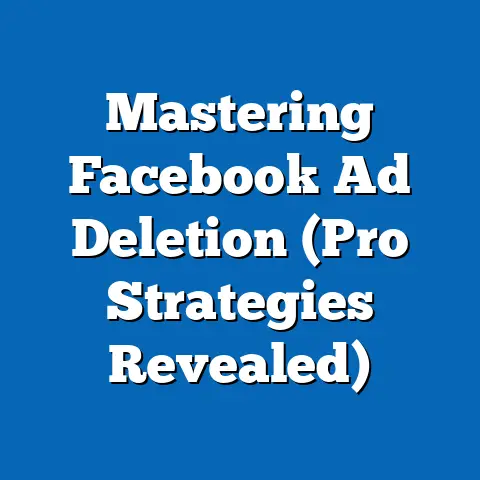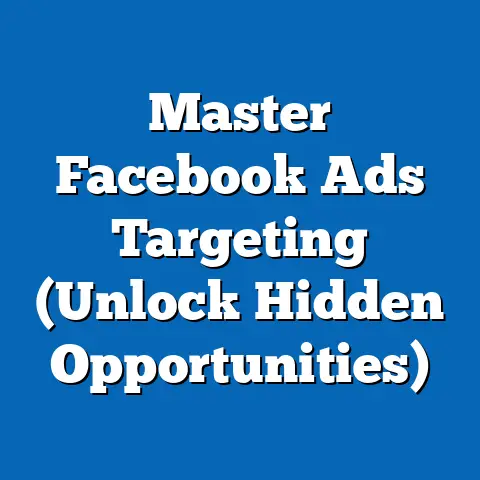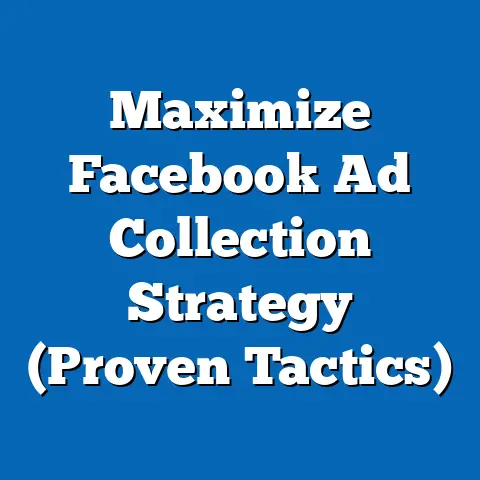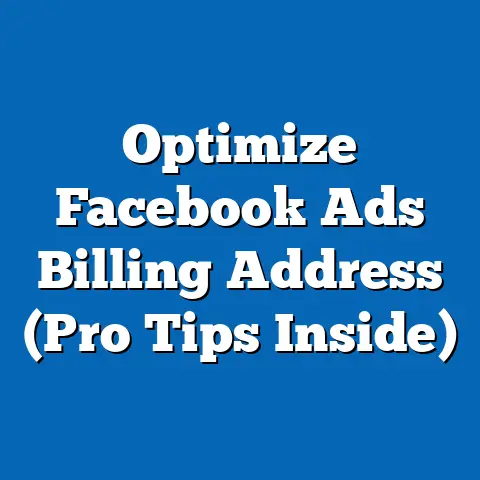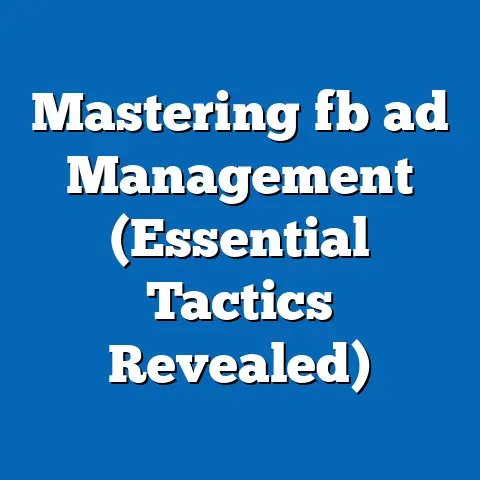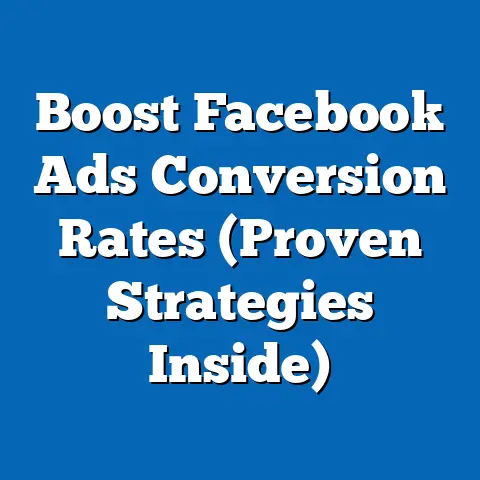Resolve Facebook Ad Visibility Issues (Expert Strategies)
What if you’ve meticulously crafted the perfect Facebook ad campaign, targeting the ideal audience with the most appealing visuals and copy, only to find that your ads are barely being seen? As a business owner or marketer, this scenario can be incredibly frustrating. You’ve invested time, effort, and money into creating ads that you believe will resonate with your audience, yet the visibility is lacking. I’ve been there, staring at analytics that showed impressions lower than my expectations despite all the upfront effort. It’s a sinking feeling, like shouting into a void. But don’t despair! This article will delve into the common reasons behind Facebook ad visibility issues and provide expert strategies to resolve them, ensuring that your ads reach their full potential. Think of it as a troubleshooting guide, a collection of hard-won lessons from the trenches of Facebook advertising, designed to help you amplify your message and connect with your ideal customers.
Understanding Facebook Ad Visibility
Facebook ad visibility is the degree to which your ads are seen by your target audience. It’s not just about the number of people who could see your ad, but the number who actually do. High visibility means your ad is appearing frequently in the feeds of people who are most likely to be interested in your product or service. This is crucial for campaign success because it directly impacts brand awareness, website traffic, lead generation, and ultimately, sales. Without adequate visibility, even the most compelling ad creative will fall flat.
Think of it like opening a shop. You can have the best products in the world, but if your shop is hidden down a back alley where no one ever walks, you won’t get any customers. Facebook ad visibility is about making sure your shop is on the busiest street in town, attracting the right kind of foot traffic.
Ad Impressions and Reach
Two core metrics that quantify visibility are impressions and reach.
- Impressions represent the number of times your ad is displayed, regardless of whether it’s clicked or engaged with. One person can account for multiple impressions if they see your ad more than once.
- Reach is the total number of unique individuals who have seen your ad. It’s a measure of audience size, telling you how many different people you’ve managed to expose your message to.
A high number of impressions with a low reach suggests your ad is being shown repeatedly to the same people, which could lead to ad fatigue. A low number of impressions, on the other hand, indicates a more fundamental visibility problem. You might be targeting too narrow an audience, or your bids might be too low to win ad auctions.
I remember once running a campaign where the impressions were high, but the reach was surprisingly low. After digging into the data, I realized I was targeting a very small, highly engaged audience. While they were seeing my ad frequently, I wasn’t expanding my reach to new potential customers. This led me to broaden my targeting criteria and refresh my creative to avoid ad fatigue.
The Significance of Ad Ranking
Facebook uses an ad auction system to determine which ads are shown to which users. Your ad’s ranking in this auction directly affects its visibility. Ad ranking is determined by several factors, including:
- Bid: How much you’re willing to pay to show your ad.
- Estimated Action Rates: Facebook’s prediction of how likely users are to engage with your ad (e.g., click, like, comment, share).
- Ad Quality and Relevance: How relevant and engaging your ad is to the target audience.
Ads with higher rankings are shown more frequently and in more prominent placements, resulting in increased visibility. Lower-ranking ads may be shown less often, or not at all. To improve your ad ranking, you need to focus on all three factors: bidding competitively, creating engaging ads, and targeting the right audience.
Impact of Audience Targeting on Visibility
Your audience targeting strategy has a massive impact on your ad’s visibility. A very narrow audience might result in high engagement rates, but it can also limit your reach and overall visibility. On the other hand, a very broad audience might increase your reach but lead to lower engagement rates and wasted ad spend on people who are not interested in your product or service.
Finding the right balance is key. You need to target an audience that is large enough to provide sufficient reach but specific enough to ensure relevance and engagement. This often involves a process of testing and refinement, using Facebook’s audience insights and analytics to identify the most responsive segments.
Common Reasons for Low Visibility
Understanding the reasons behind low visibility is the first step towards fixing the problem. Here are some of the most common culprits:
Poor Ad Relevance Score
The ad relevance score is a metric that Facebook uses to assess how relevant and engaging your ad is to its target audience. It’s a score from 1 to 10, with 10 being the highest. A higher relevance score generally leads to lower costs and increased visibility. A low relevance score, on the other hand, can significantly limit your ad’s reach and increase your advertising costs.
Facebook calculates the relevance score based on a variety of factors, including:
- Positive Feedback: Likes, comments, shares, and clicks on your ad.
- Negative Feedback: Users hiding your ad or reporting it as spam.
- Overall Engagement: How users interact with your ad.
If your ad has a low relevance score, it means that Facebook believes your ad is not resonating with your target audience. This could be due to a number of reasons, such as:
- Irrelevant Targeting: Your ad is being shown to people who are not interested in your product or service.
- Poor Ad Creative: Your ad copy or visuals are not engaging or compelling.
- Misleading Content: Your ad is making promises that it can’t keep.
Audience Saturation
Audience saturation occurs when your target audience has been repeatedly exposed to your ad, leading to ad fatigue. When people see the same ad over and over again, they become less likely to engage with it, and they may even start to ignore it altogether.
This can lead to a decrease in engagement rates, a lower relevance score, and ultimately, reduced visibility. To avoid audience saturation, it’s important to:
Budget Constraints
Your advertising budget directly impacts your ad’s visibility. If your budget is too low, Facebook will not be able to show your ad to enough people to achieve your desired results. This is especially true in competitive industries where there are many other advertisers vying for the same audience.
To ensure adequate visibility, you need to set a budget that is sufficient to reach your target audience and achieve your campaign goals. This might involve increasing your daily or lifetime budget, or adjusting your bidding strategy to be more competitive.
Ad Quality and Engagement
Facebook prioritizes ads that are high quality and engaging. Ads with low engagement rates (e.g., few likes, comments, shares, or clicks) are less likely to be shown to a large audience. This is because Facebook wants to provide its users with a positive experience, and showing them irrelevant or unengaging ads would detract from that experience.
To improve your ad quality and engagement, you need to focus on creating ads that are:
- Relevant: Your ads should be relevant to the interests and needs of your target audience.
- Engaging: Your ads should be visually appealing and contain compelling copy that encourages users to take action.
- High Quality: Your ads should be well-designed and free of errors.
Competing Ads
In a crowded marketplace, your ads are competing with many other ads for the attention of your target audience. If there are many other advertisers targeting the same audience with similar ads, your ad’s visibility may be reduced.
To stand out from the competition, you need to create ads that are unique, compelling, and highly relevant to your target audience. You also need to monitor your competitors’ ads and adjust your strategy accordingly. This might involve:
- Differentiating Your Message: Highlighting what makes your product or service unique.
- Improving Your Ad Creative: Creating more visually appealing and engaging ads.
- Refining Your Targeting: Finding niche audiences that are less saturated with competing ads.
Expert Strategies to Improve Ad Visibility
Now that we’ve identified the common reasons for low visibility, let’s dive into the expert strategies you can use to improve your ad performance.
1. Enhancing Ad Relevance
Improving your ad relevance is crucial for boosting visibility and reducing advertising costs. Here’s how:
- Craft Compelling Ad Copy: Your ad copy should be clear, concise, and relevant to your target audience. Highlight the benefits of your product or service and address their pain points. Use strong calls to action that encourage users to take the desired action.
- Use High-Quality Visuals: Your ad visuals should be visually appealing and relevant to your ad copy. Use high-resolution images or videos that capture attention and convey your message effectively.
- A/B Test Your Creative: Continuously test different ad copy, visuals, and calls to action to identify what resonates best with your target audience. Use Facebook’s A/B testing tools to compare the performance of different ad variations and optimize your campaigns accordingly.
I once worked with a client who was struggling with low ad relevance scores. Their ad copy was generic and their visuals were uninspired. We completely revamped their ad creative, focusing on highlighting the unique benefits of their product and using visually stunning images. The result was a dramatic increase in their ad relevance score and a significant improvement in their ad visibility.
2. Refining Audience Targeting
Effective audience targeting is essential for reaching the right people with your ads. Here’s how to refine your targeting strategy:
- Utilize Facebook Audience Insights: Facebook Audience Insights provides valuable data about your target audience, including their demographics, interests, behaviors, and purchase patterns. Use this data to create more targeted and relevant ad campaigns.
- Create Custom Audiences: Custom audiences allow you to target people who have already interacted with your business, such as website visitors, email subscribers, or customers. This is a highly effective way to retarget potential customers who are already familiar with your brand.
- Leverage Lookalike Audiences: Lookalike audiences allow you to target people who are similar to your existing customers. This is a great way to expand your reach and find new potential customers who are likely to be interested in your product or service.
- Implement Retargeting Strategies: Retargeting involves showing ads to people who have previously visited your website or interacted with your business in some way. This is a highly effective way to re-engage potential customers who have shown an interest in your product or service.
One of my favorite strategies is to create custom audiences based on website behavior. For example, I might create a custom audience of people who visited a specific product page but didn’t add the item to their cart. Then, I would show them a retargeting ad highlighting the benefits of that product and offering a special discount to encourage them to complete the purchase.
3. Optimizing Budget and Bidding Strategies
Your budget and bidding strategy directly impact your ad’s visibility. Here’s how to optimize them:
- Set an Appropriate Budget: Ensure that your budget is sufficient to reach your target audience and achieve your campaign goals. Consider increasing your daily or lifetime budget if you’re not seeing the desired results.
- Choose the Right Bidding Strategy: Facebook offers a variety of bidding strategies, including cost-per-click (CPC), cost-per-impression (CPM), and cost-per-conversion (CPA). Choose the bidding strategy that is most appropriate for your campaign goals.
- CPC: Pay only when someone clicks on your ad. This is a good option if your goal is to drive traffic to your website.
- CPM: Pay for every 1,000 impressions of your ad. This is a good option if your goal is to increase brand awareness.
- CPA: Pay only when someone completes a desired action, such as making a purchase or filling out a form. This is a good option if your goal is to generate leads or sales.
- Monitor Your Campaign Performance: Regularly monitor your campaign performance and adjust your budget and bidding strategy accordingly. If you’re not seeing the desired results, consider increasing your budget or switching to a different bidding strategy.
- CPC: Pay only when someone clicks on your ad. This is a good option if your goal is to drive traffic to your website.
- CPM: Pay for every 1,000 impressions of your ad. This is a good option if your goal is to increase brand awareness.
- CPA: Pay only when someone completes a desired action, such as making a purchase or filling out a form. This is a good option if your goal is to generate leads or sales.
I’ve found that using a CPA bidding strategy can be highly effective for driving conversions, but it requires careful monitoring and optimization. You need to ensure that your ads are highly relevant and engaging, and that your landing page is optimized for conversions.
4. Utilizing Facebook Ad Tools
Facebook offers a variety of tools to help you manage and optimize your ad campaigns. Here are some of the most important tools to utilize:
- Ads Manager: Ads Manager is the central hub for creating, managing, and analyzing your Facebook ad campaigns. Use Ads Manager to set up your campaigns, target your audience, set your budget, and track your results.
- Audience Insights: As mentioned earlier, Audience Insights provides valuable data about your target audience, including their demographics, interests, behaviors, and purchase patterns.
- Facebook Pixel: Facebook Pixel is a piece of code that you can install on your website to track the actions that people take on your site after clicking on your Facebook ad. Use Facebook Pixel to track conversions, retarget website visitors, and optimize your ad campaigns.
The Facebook Pixel is an absolute game-changer. It allows you to track the effectiveness of your ads and optimize your campaigns for conversions. If you’re not using the Facebook Pixel, you’re missing out on a huge opportunity to improve your ad performance.
5. Engagement Strategies
Boosting engagement on your ads is crucial for increasing visibility and improving your ad relevance score. Here’s how to boost engagement:
- Ask Questions: Asking questions in your ad copy can encourage users to comment and interact with your ad.
- Run Contests and Giveaways: Contests and giveaways are a great way to generate excitement and engagement around your ads.
- Use Interactive Content: Interactive content, such as polls and quizzes, can be highly engaging and encourage users to interact with your ad.
- Encourage User-Generated Content: Encourage your customers to share their experiences with your product or service and feature their content in your ads.
- Respond to Comments and Messages: Respond promptly to comments and messages on your ads to show that you’re engaged and responsive.
I’ve seen great success with running contests and giveaways. They’re a great way to generate buzz and engagement around your brand, and they can also help you collect valuable leads.
6. Analyzing Ad Performance
Regularly analyzing your ad performance is essential for identifying areas for improvement and optimizing your campaigns. Here’s how to analyze your ad performance:
- Track Key Metrics: Track key metrics such as impressions, reach, clicks, conversions, cost-per-click (CPC), cost-per-conversion (CPA), and return on ad spend (ROAS).
- Identify Trends and Patterns: Look for trends and patterns in your data to identify what’s working and what’s not.
- Use A/B Testing: Continuously test different ad variations to identify what resonates best with your target audience.
- Adjust Your Campaigns: Based on your analysis, adjust your campaigns to improve performance. This might involve refining your targeting, updating your ad creative, or adjusting your budget and bidding strategy.
I always create a dashboard to track the key metrics for my campaigns. This allows me to quickly identify any potential problems and take corrective action.
Case Studies and Real-World Examples
Let’s look at some real-world examples of how businesses have successfully resolved their ad visibility issues.
Case Study 1: E-commerce Business
An e-commerce business selling handmade jewelry was struggling with low ad visibility and high advertising costs. Their ad relevance scores were low, and their ads were not generating many sales.
After analyzing their campaigns, they realized that their targeting was too broad and their ad creative was not compelling. They refined their targeting to focus on specific interests and demographics, and they created new ad creative that highlighted the unique craftsmanship and artistry of their jewelry.
The result was a dramatic increase in their ad relevance scores, a significant improvement in their ad visibility, and a substantial increase in their sales.
Case Study 2: Local Restaurant
A local restaurant was struggling to attract new customers through Facebook ads. Their ads were not being shown to enough people, and they were not generating many reservations.
After analyzing their campaigns, they realized that their budget was too low and their ads were not engaging. They increased their budget and created new ad creative that showcased their delicious food and inviting atmosphere. They also ran a contest offering a free meal to one lucky winner.
The result was a significant increase in their ad visibility, a surge in reservations, and a boost in their overall business.
Key Takeaways from These Cases:
- Targeting Matters: Refining your targeting to reach the right people is crucial for improving ad visibility and reducing advertising costs.
- Creative is King: Creating compelling ad creative that resonates with your target audience is essential for driving engagement and improving ad relevance scores.
- Budget is Important: Setting an appropriate budget is necessary to reach your target audience and achieve your campaign goals.
- Engagement Drives Visibility: Boosting engagement on your ads can significantly improve your ad visibility and overall campaign performance.
Conclusion
Addressing ad visibility issues is critical for the overall success of your Facebook ad campaigns. As I’ve learned through my own experiences, ignoring these issues can lead to wasted ad spend and missed opportunities. By applying the expert strategies outlined in this article, you can enhance your ad performance, reach your target audience more effectively, and ultimately drive better results from your advertising efforts. Remember to continuously monitor your campaign performance, test different ad variations, and adjust your strategy accordingly. Facebook advertising is an ongoing process of learning, adapting, and optimizing. Embrace the challenge, stay informed, and you’ll be well on your way to achieving your advertising goals.

